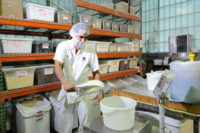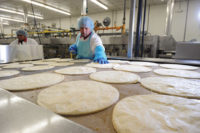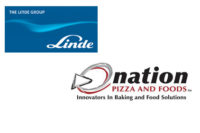Nation Pizza and Foods’ facilities are always bustling. The aroma of buttery pizza crust and delectable pizza sauce waft through the air at the company’s Schaumburg, Ill., production facility and headquarters, where some 1,000 employees work. During a visit to the high-speed, 190,000-sq.-ft. production plant, Snack Food & Wholesale Bakery toured one of the facility’s two bakeries, which is equipped with a low-stress production line that was running 6-in.-round pizza crusts. “Here, we produce well more than 30,000 lb. of dough an hour,” observes Mike Alagna, chief operations officer, who led us on a guided tour.
We also visited one of two elaborate topping rooms, which was running (among many other things) a 12-in. frozen pizza for one of the country’s biggest food companies.
“We have to be on our toes in the plant,” says president Richard Auskalnis. “When we bought this facility, it was only 100,000 sq. ft. in size. We added another 90,000 sq. ft. in 1999 because demand was incredibly high, and we were running out of room.”
The company expanded even further in 2002 when it purchased a second production facility in McPherson, Kan., that spans 100,000 sq. ft. and now has about 400 employees. “We make a lot of other things here in Schaumburg, but in McPherson, we make more of the hand-held items, desserts, more of the specialty items and appetizers,” Auskalnis says.
But grow Nation Pizza and Foods has. Its 400-450 stock-keeping units (SKUs) include frozen pizza products and an array of other baked treats, which are more popular today than ever. The Schaumburg facility operates three shifts a day, five to seven days a week, in its four pizza-topping rooms. The bakeries there run 24 hours a day. The company has upgraded the operations to stay on top of things to best accommodate its large group of customers. “We always look at new systems and equipment because we want to stay ahead of changes, such as the food safety act,” Alagna adds. “We take the safety of our products and consumers very seriously—we won’t jeopardize that. We’re also big believers in sustainability: Protecting the environment for the future.”
In constant motion
The company copacks, contract packages and creates recipes for numerous customers across the county, so the processing and packaging lines are constantly being changed over. That means the Nation Pizza and Foods team must be as nimble and flexible as possible.
“We change over so much because our customers are all different and all want something different,” Alagna explains. “We’ve been doing that for years. Our core customers haven’t really changed but the amount of customers we have is increasing all the time, so we’re always moving. It’s like being an orchestra leader. We ensure that everyone has something to do, and we try to have everything changed in about 30 minutes to an hour and a half, depending on the situation.”
Using a just-in-time schedule, the plant currently produces enough frozen products to fill 25 to 30 outbound trucks each day. “The exact amount we produce varies each day,” says Alagna. “Some trucks will require 5,000 cases and others 1,800 cases.”
Raw ingredients are stored on two sides of the facility and the bulk of the ingredients is stored offsite at the company’s distribution center nearby.
Mixing, sheeting, proofing
In the bakery we toured, conveyors seemed to be everywhere. The freezer room features recently installed air-lock doors, which eliminate frost and cut electricity use, the operations officer says. “They are part of our energy conservation program,” explains Alagna. “Our forklifts can easily drive in and out. The freezer is set at zero to -5 deg. F. The former doors were being opened so much that we really needed an automatic system.”
We enter the mixing area, where two large mixers operate with flour, water, yeast and oil to produce batches of dough weighing up to 1,600 lb. each. The ingredients are added to the batch automatically and are dispensed into the troughs via computer-programmed pumps. All of the product formulations are stored in a main computer. The flour is pumped to the room from four indoor 100,000-lb. silos—two silos are dedicated to each bakery. Minor ingredients are added from large intermediate bulk containers. Liquid yeast is pumped in from two holding tanks.
“The only other thing we add is what we call ‘scrap’ dough,” Alagna says. “We recycle dough from the cutter. It conveys back into the mixer to add flavor and enhance the fine, even texture of the pizza crust and makes it tender.”
A specially designed scrap-dough return system collects the matrix of dough that gets cut away from the pizza rounds and repurposes it back into the batch mixture. The scrap conveys around the corner and into another room, up over the line’s main conveyor and back to the mixing area. Meanwhile, the just-made dough sits for a time to get more flavor before it’s transferred to a low-stress line to be sheeted, which reduces the thickness substantially and flattens the dough for cutting. Able to produce crusts from 4 to 16 in. in diameter, the low-stress line is computer-controlled. “It doesn’t overwork the dough, it just pulls it slightly,” explains Alagna.
Next, the dough is placed in a dough trough that automatically elevates and dumps the dough into the hopper or coffin of a chunker, which rolls out the dough and feeds uniform chunks of it to downstream divider/forming equipment. Flour continues to be added automatically to the dough as it travels through the system to prevent sticking to the conveyor belt. “We just added a new multi-roller about three months ago,” says Alagna. “That really thins the dough out evenly.”
The 20-ft.-long sheeter reduces the wide slab of dough to a specific thinness. In this case, it is reduced to a thickness of 3⁄8 in. The dough is then pressed and turned or flipped over automatically by rollers. Oil can be added at this point, if the customer has requested it. The dough is rolled out further and die-cut into 6-in. rounds.
The crusts convey four-across onto pizza pans that have conveyed into the room through an opening in a wall and travel under and up to the line. There are 12 pockets in each pan to hold the rounds of dough rounds.
The dough-filled pans travel to a proofer after line workers ensure that the dough is properly aligned in the pans. The pans then climb up to the plant’s mezzanine level where a spiral proofer uses heat and humidity to relax the dough and allows it to rise. Alagna says proofing temperatures vary, but in this case, the dough proofs at 105 deg. F for about 4 minutes at 85% relative humidity (RH).
After the pans of crust are proofed, they exit on the other side of the room and convey back down to the main floor. Line operators check the crusts again for proper alignment on the pans and the rounds convey through a press that pats them in the middle.
Baking, topping details
Next, the rounds are automatically docked so the dough doesn’t expand and puff out before they convey to an 85-ft.-long, five-zone impinged-air tunnel oven to be par-baked. The coated anodized steel pans have holes that allow the crusts to “breathe” and stay flat. As the pans convey toward the oven, they are removed by a vacuum depanning system while the dough rounds are deposited onto a wire mesh conveyor leading to the oven.
Alagna says the rounds bake for about 3 minutes at 375 to 400 deg. F total, but each zone in the oven is different, so will bake in some areas at 150 deg. F, depending on specified settings. After baking, a blower cools the golden brown crusts slightly, and they cool even more as they convey toward a spiral ammonia freezer in a room off to the side of the main production area. Inside the freezer, the crusts freeze at -35 deg. F for about 15 to 27 minutes.
Next we proceed to the main pizza-topping room, where frozen pizzas are being made for a large well-known manufacturer. A sauce-mixing area pumps tomato paste out of large bulk totes per computer-controlled measurements, “so that we know how much paste, water, oil, seasonings are going into the mixture,” Alagna says. The topping rooms are regulated and inspected by the U.S. Department of Agriculture (USDA) and set at a temperature of 50 deg. F or lower. During our visit to this room, frozen crusts measuring 12 in. in diameter are placed on the line two-across and convey toward a sauce depositor. In this case, the customer wants the sauce to extend all the way to the edge of the crust.
Sausage crumbles are added automatically before the crusts travel to a cheese waterfall where mozzarella shredded in-house rains down on the sausage and sauce-topped crusts. “These pizzas are bypassing a vegetable applicator, but we have additional stations on this line for veggies,” says Alagna. More sausage is added and then the pizzas progress to a pepperoni stick slicing/topping station. There are four waterfall applicators available in case a customer wants ingredients added before the cheese is applied. “Some customers have different sequences,” Alagna explains.
Next, the pizzas progress to a custom system Alagna invented called a premelter. “When I got into the pizza business, people would spray pizzas with water to start melting the cheese so that everything would stick together when the pizzas were frozen,” he says. “But it wasn’t practical, so I figured that toasting the pizza using infrared heat would lightly start the melting process and everything will stick properly.”
Look like homemade
Loaded with all of the toppings, the pizzas look homemade. They’re now ready for the freezer, which in this case is a nitrogen tunnel freezer that cools the products down to -70 to -100 deg. F, which only takes 7.5 minutes.
The frozen pizzas emerge and convey out of the topping room and into the large packaging room. “We have modified atmosphere (MAP) capabilities if they’re needed,” Alagna points out. Like the topping rooms, the large packaging room with multiple production lines can be set up or rearranged per customer requests. Today, portion-controlled, hand-held pizza products are being wrapped in shrink film on one of seven wrapping lines while another line handles a large round pizza. “Everything can be customized in this room,” says Alagna.
At this stage, the lines merge into one and convey to a checkweighing/metal detection station and then into the infeed into the cartoner. The pizzas are cartoned at speeds up to 300 cartons per minute before the filled, sealed cartons are ink-jet-coded.
The cartons are then removed from the line and are tested via statistical process control (SPC) for weights and measures. “We also have Hazardous Analysis Critical Control Points (HACCP) all over the plant,” adds Alagna. “In the bakery, the flour sifters are a control point and when the flour is pulled out of the silos, every ounce of it is checked. Here, the metal detector is another critical control point. If metal is found, the pizza is kicked off into a bin. If something is found, it’s tossed.”
Currently, the pizzas are case packed manually, but Nation Pizza and Foods may install automatic case packers “We found a case packer that will fit,” he says. “We collaborate with our vendors on equipment designs so we can get custom machinery if it suits our needs.”
Workers load 12 cartons per shipping case and send the cases through an automatic tape sealer and ink-jet coder that generates a best-by code and production information. Both ends of the load are labeled with scannable data. Then, the loads are forklifted to an automatic pallet wrapper that secures each load for freezer storage.
Keeping things in perspective
There’s so much going on at the plant, yet everything is balanced, from the high-speed production to the quality, safety and security programs. “SPC helps,” Alagna says. “We can modify everything to make it run faster, smoother or better because we slowly increase the speed of production while quality, controls and safety are all in place.”
A small testing lab near the office area will be remodeled soon, Alagna points out. “We’re also about to add another small production line and just added two pizza wrappers.”
Other investment plans include automating the case packaging sequences with equipment to fit into the already fully equipped packaging room. “We’re looking at case packers that have integral robots that load the products,” Alagna states.
The company is also actively looking at acquisitions to grow its business even more, so another expansion will be taking place some time in the future, Auskalnis says.
The energetic plant may have probably $70 million worth of equipment in it, but it’s nothing without the people, says Alagna in tribute to what he’s most proud of—the employees.
“It’s all about how we treat our people, which is why so many of them have been here so long,” Auskalnis explains. “We work hard and we play hard and believe in having fun. It’s the culture here that’s important.”
















